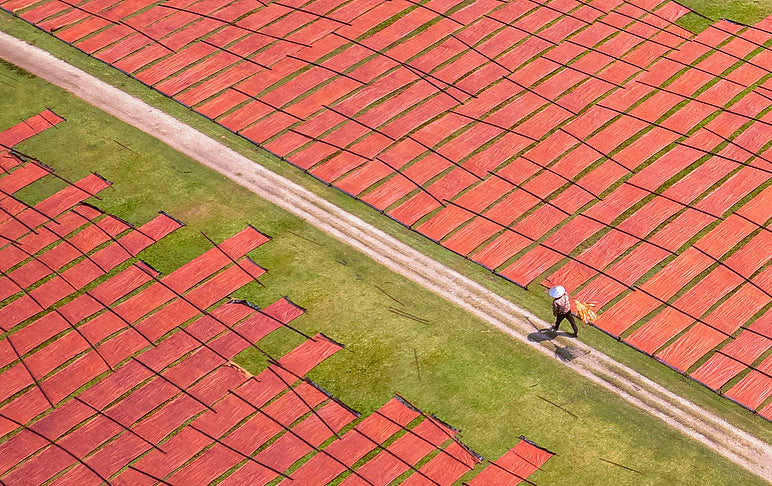Skip to content
Mud Silk, the naturally bred Fabric
What is the mud silk?
Mud Silk, commonly known as Gambiered Canton Gauze, is a silk fabric crafted
through a unique process of coating and dyeing mulberry silk with the extract of the
gambier plant (Dioscorea cirrhosa), followed by treatment with mineral-rich river
mud and prolonged sun exposure. It stands as one of the world's exceedingly rare
silk textiles dyed exclusively with pure botanical dyes.
The dyeing and finishing technique of mud silk is recognized as a National Intangible
Cultural Heritage of China. Though its history may not span as long as that of cotton,
linen, silk, or wool in human civilization, it has nevertheless left a distinctive imprint
over the centuries.
How did the mud silk come from:
Historical records indicate that mud silk first emerged in the 15th century, during the
Ming Dynasty, when it began its production and export to the world. The Pearl River
Delta in Guangdong Province was a major region for sericulture and silk production.
In Shunde City, located near the estuary of the Pearl River system, the main
tributarie —the West River and the North River—originate from the towering
mountains of Guangxi and Hunan. As these rivers traverse hundreds of miles of
relatively gentle hilly terrain, they branch into countless tributaries, forming an
intricate network of waterways with slowed currents. Over time, a fine, sand-free silt
gradually settled on the riverbeds, forming one of the key materials used in the
traditional mud silk dyeing process—the mineral-rich river mud.
Dioscorea cirrhosa

The flat terrain along the riverbanks offered ample space for cultivating grass,
forming the essential sun-drying grounds for the gambiering process. Another key
ingredient—the gambier plant—grew abundantly on the surrounding foothills. Thus,
all the essential elements for producing mud silk converged here: a long-established
silk industry, readily available natural dyes, unpolluted river mud formed through
centuries of sedimentation, and the abundant sunlight characteristic of the Tropic of
Cancer region. It is through skilled human hands that these elements are masterfully
woven together, giving form to this remarkable fabric. Truly, it is a material
bestowed by nature—a gift nurtured and brought to life by the earth itself.
As story has it, fishermen in the Pearl River Delta once discovered that soaking their
fishing nets in gambier plant extract made the nets remarkably strong and durable.
This inspired them to treat their clothing with the same method, resulting in
garments that were similarly stiff and well-structured. When the treated fabric came
into contact with river mud, it developed a glossy black sheen. Over time, the cloth
grew softer with wear while retaining its durability. Thus, locals began applying the
gambier treatment not only to fishing nets but also to textiles, gradually developing
the unique regional silk fabric known today as mud silk.

The difference between mud silk and simple silk:
From a production standpoint, mud silk undergoes a unique dyeing process that
relies heavily on artisanal handcrafting, in stark contrast to the industrialized
manufacturing of most modern silks.
Visually, the face side of mud silk is characterized by distinctive crackled ice patterns
or cicaya-wing textures, with subtle variations in hue that make each piece one-of-a
kind. Conventional silk, on the other hand, typically boasts vibrant colors and a
pearlescent sheen—a different kind of luminosity compared to the glossy black
derived from the river mud treatment on mud silk.
In terms of texture, mud silk feels initially stiff and structured, softening
progressively with wear, whereas conventional silk is celebrated for its immediate,
butter-soft smoothness from the very first touch.
The process of making mud silk:
The production process of mud silk is exceptionally intricate. The primary
components of gambier extract are polyphenols and tannins, which readily oxidize
and denature, producing a coagulating effect. When these compounds chemically
react with the high-valence iron ions present in the river mud, they form black
precipitates that consolidate on the surface of the silk fabric. This reaction gives the
fabric its characteristically stiff texture and glossy black coloration.
Traditionally, the entire manufacturing process of mud silk is handcrafted. A
complete dyeing cycle alone requires approximately 15 days, which can be extended
due to weather conditions such as rainfall. When including post-processing steps, the
entire production can span from three months to half a year.

After the plain silk fabric is prepared, four distinct concentrations of gambier dye
liquid are prepared. The process involves three separate stages of dyeing and sun
drying, followed by the application of river mud to the surface. After washing, the
fabric is sun-dried once more before undergoing the third and final dyeing stage
only then is the core production process considered complete. Finally, the fabric is
left to absorb moisture from the air and undergoes a maturation period of 3 to 6
months before being washed again, at which point the entire process is thoroughly
finalized.
- Choosing a selection results in a full page refresh.
- Opens in a new window.



